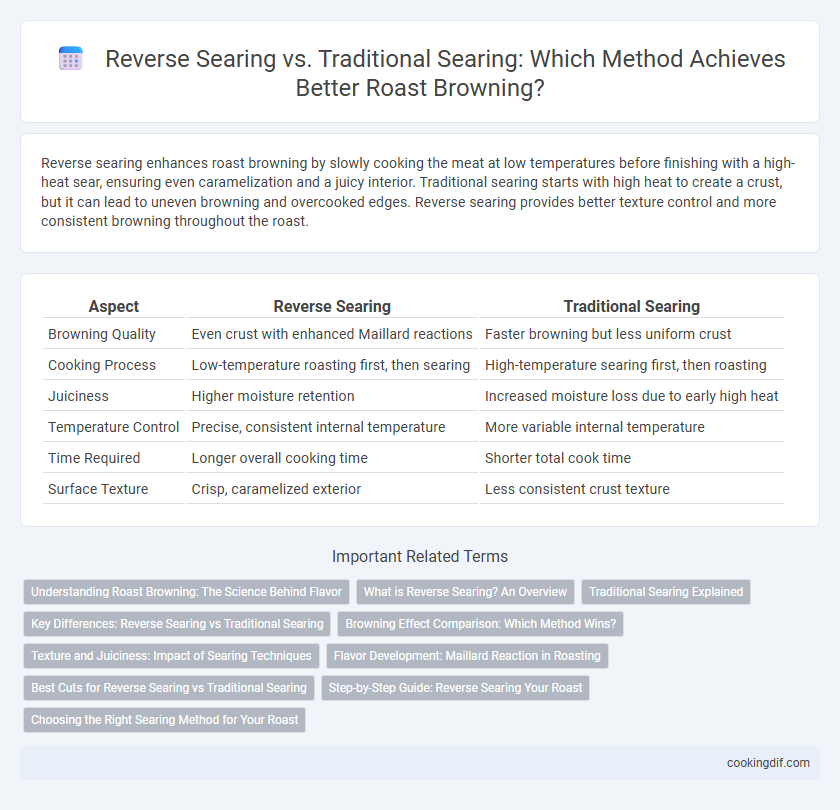Reverse searing enhances roast browning by slowly cooking the meat at low temperatures before finishing with a high-heat sear, ensuring even caramelization and a juicy interior. Traditional searing starts with high heat to create a crust, but it can lead to uneven browning and overcooked edges. Reverse searing provides better texture control and more consistent browning throughout the roast.
Table of Comparison
| Aspect | Reverse Searing | Traditional Searing |
|---|---|---|
| Browning Quality | Even crust with enhanced Maillard reactions | Faster browning but less uniform crust |
| Cooking Process | Low-temperature roasting first, then searing | High-temperature searing first, then roasting |
| Juiciness | Higher moisture retention | Increased moisture loss due to early high heat |
| Temperature Control | Precise, consistent internal temperature | More variable internal temperature |
| Time Required | Longer overall cooking time | Shorter total cook time |
| Surface Texture | Crisp, caramelized exterior | Less consistent crust texture |
Understanding Roast Browning: The Science Behind Flavor
Reverse searing enhances roast browning by slowly cooking the meat at low temperatures, allowing Maillard reaction compounds to develop evenly before a high-heat sear forms a flavorful crust. Traditional searing exposes the roast to intense heat first, creating an immediate browned exterior but risking uneven internal cooking and less uniform flavor development. Understanding these methods' impact on Maillard reactions and moisture retention is crucial for optimizing roast flavor and texture.
What is Reverse Searing? An Overview
Reverse searing is a cooking technique where the roast is first cooked slowly at a low temperature and finished with a high-heat sear to develop a crispy, browned crust. This method ensures even internal cooking and reduces the risk of overcooking the outer layers compared to traditional searing, which starts with high heat to brown the roast before finishing at a lower temperature. Reverse searing enhances flavor through Maillard reaction while maintaining optimal juiciness and tenderness throughout the roast.
Traditional Searing Explained
Traditional searing involves cooking the roast at high heat initially to create a caramelized, flavorful crust through the Maillard reaction. This method effectively locks in juices and enhances the texture by forming a brown outer layer before finishing the roast at a lower temperature. The intense direct heat applied at the beginning is key to developing a deep, rich flavor characteristic of classic roasts.
Key Differences: Reverse Searing vs Traditional Searing
Reverse searing involves slowly cooking the roast at a low temperature before finishing with a high-heat sear to create an even crust, while traditional searing starts with a high-heat sear followed by roasting. Reverse searing offers more uniform doneness and better moisture retention, whereas traditional searing can produce a more pronounced crust but carries a higher risk of uneven cooking. The key difference lies in the sequence of temperature application, impacting texture and juiciness in the final roast.
Browning Effect Comparison: Which Method Wins?
Reverse searing produces a more uniform and deeper browning on roasts by slowly rendering fat and proteins before applying high heat, enhancing the Maillard reaction evenly across the surface. Traditional searing subjects the roast directly to intense heat, often resulting in a crustier, sometimes unevenly browned exterior but less control over interior doneness. For optimal roast browning, reverse searing often wins by delivering consistent color and flavor while maintaining juiciness.
Texture and Juiciness: Impact of Searing Techniques
Reverse searing involves slow-cooking the roast at a low temperature before finishing with a high-heat sear, resulting in a consistent medium-rare interior and a well-developed crust that enhances tenderness and moisture retention. Traditional searing, performed first over high heat, creates a flavorful crust but often causes uneven cooking and a drier center due to moisture loss from rapid heat exposure. Studies show reverse searing significantly improves juiciness by reducing temperature gradients, preserving the roast's natural juices and ensuring a tender texture throughout.
Flavor Development: Maillard Reaction in Roasting
Reverse searing enhances flavor development in roasting by allowing the Maillard reaction to occur more evenly at the end of cooking, resulting in a deeply browned, flavorful crust without overcooking the interior. Traditional searing applies high heat upfront, rapidly triggering the Maillard reaction but risking a less uniform crust and a potentially less tender center. The controlled temperature gradient in reverse searing promotes complex flavor compounds, maximizing the savory and caramelized notes characteristic of expertly roasted meats.
Best Cuts for Reverse Searing vs Traditional Searing
Reverse searing excels with thick, marbled cuts like ribeye and prime rib, allowing even cooking and enhanced flavor development through gradual temperature rise. Traditional searing suits thinner steaks such as sirloin or flank, where high heat quickly locks in juices and forms a crust before roasting. Choosing the right method depends on cut thickness and fat content to optimize browning and tenderness in roast preparation.
Step-by-Step Guide: Reverse Searing Your Roast
Start by seasoning the roast and cooking it in a low-temperature oven (around 225degF or 107degC) until it reaches an internal temperature about 10-15degF below your target doneness. Remove the roast and sear it in a hot cast-iron skillet or on a grill for 1-2 minutes per side to create a browned crust. Rest the roast for 10 minutes before slicing to ensure juices redistribute for maximum tenderness and flavor.
Choosing the Right Searing Method for Your Roast
Reverse searing delivers evenly cooked roasts with a consistent browned crust by slowly bringing the meat to temperature before a high-heat finish, minimizing overcooking and enhancing flavor. Traditional searing develops a crust upfront by applying high heat initially, locking in juices but risking uneven cooking and potential dryness. Selecting the right searing method depends on meat thickness, desired doneness, and the balance between crust development and internal tenderness.
Reverse searing vs traditional searing for roast browning Infographic

 cookingdif.com
cookingdif.com